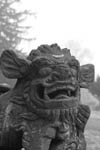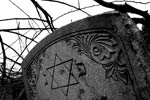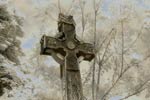As I walk through the valley of the shadow of death, I can’t help but notice that cemeteries live and breathe reminders of lives well spent and just rewards. Besides the ambiance, symbolism is just one of the many things cemeteries offer-perhaps it is the main thing. Take a short tour through some cemeteries as we delve into some symbolism we take for granted. Some are common, some not so common.
Angel
 At life’s end, some of us would like to believe that angels, as our celestial companions, will bear us home. Not surprisingly then, angels are a common symbol in cemeteries. It could be argued that angels benefit the living more than the dead-they offer us comfort while softening the finality of death. Personally, I see them as the embodiment of the tension between freedom and confinement-a tension we all feel. These angels reside inside a crypt in Baltimore’s Greenmount Cemetery. They sit with heads bowed, as if guarding the bodies of the departed souls, alleviating the gloom of these below-ground family burial places.
At life’s end, some of us would like to believe that angels, as our celestial companions, will bear us home. Not surprisingly then, angels are a common symbol in cemeteries. It could be argued that angels benefit the living more than the dead-they offer us comfort while softening the finality of death. Personally, I see them as the embodiment of the tension between freedom and confinement-a tension we all feel. These angels reside inside a crypt in Baltimore’s Greenmount Cemetery. They sit with heads bowed, as if guarding the bodies of the departed souls, alleviating the gloom of these below-ground family burial places.
Foo Dogs
 Another type of protector–this one spiritual– is the foo dog, which guards Chinese graves. This lion-like creature resulted when Indian Buddhist missionaries described lions to Chinese artists (who were not familiar with such beasts!). These powerful mythic guardians have traditionally stood in front of Chinese imperial palaces, emperors’ tombs and government offices since the Han Dynasty (206 BC-220 AD). There are scattered Chinese divisions in cemeteries around Philadelphia (which has a Chinatown in its center city district). This image was made in Abington, PA (northeast of Philadelphia).
Another type of protector–this one spiritual– is the foo dog, which guards Chinese graves. This lion-like creature resulted when Indian Buddhist missionaries described lions to Chinese artists (who were not familiar with such beasts!). These powerful mythic guardians have traditionally stood in front of Chinese imperial palaces, emperors’ tombs and government offices since the Han Dynasty (206 BC-220 AD). There are scattered Chinese divisions in cemeteries around Philadelphia (which has a Chinatown in its center city district). This image was made in Abington, PA (northeast of Philadelphia).
Star of David
 Not only a sign of redemption, but the universal symbol of the Jewish people. Jews use the Star of David as it was used for many centuries: as a magical good luck symbol and as a sign of Jewish identity. It has only achieved this latter status since the Middle Ages. At that time it started to appear on flags, tombstones, and synagogue decorations. The Star of David, or magen David (‘Shield of David’) gets its name from the folklore that David carried a hexagram-shaped shield during his defeat of Goliath. Hence the symbol’s association with protection and good luck.
Not only a sign of redemption, but the universal symbol of the Jewish people. Jews use the Star of David as it was used for many centuries: as a magical good luck symbol and as a sign of Jewish identity. It has only achieved this latter status since the Middle Ages. At that time it started to appear on flags, tombstones, and synagogue decorations. The Star of David, or magen David (‘Shield of David’) gets its name from the folklore that David carried a hexagram-shaped shield during his defeat of Goliath. Hence the symbol’s association with protection and good luck.
Read more:
Celtic Cross
 When we look at the cross, we typically don’t think of death. More likely, we think of a holy afterlife. Christians think of redemption–salvation from sin through Christ ‘s sacrifice, allowing them entry into Heaven.
When we look at the cross, we typically don’t think of death. More likely, we think of a holy afterlife. Christians think of redemption–salvation from sin through Christ ‘s sacrifice, allowing them entry into Heaven.
While one would assume that the cross itself originated as a Christian symbol (Christ died on a cross of wood), it may surprise you to know that the cross shape itself had been used by many ancient civilizations, long before the dawn of Christianity. Cari Buziak states that “Its four arms were perfect for denoting the four elements, the four directions of the compass, and the four parts of man – mind, body, soul and heart.”
 The Celtic cross is the Latin cross with a circle over the intersection. While a commonly used Christian symbol, its origin is largely unknown and what it represents is open to interpretation. The addition of the ring around the cross has had many explanations, everything from sun worship and symbolism, to creating a shape with the cross that was well contained and aesthetically pleasing. Some hold that the Celtic cross was an ancient measuring instrument used for accurate navigation, astronomy and surveying. Others suggest that the great stone Celtic Crosses carved from the standing stones of the Druids were originally phallic symbols, just carved into crosses to disguise their original purpose. What historians do know for sure is that the symbol came into being around the ninth century, when Christianity was new to Celtic Britain and Ireland. The large stone crosses that dot the landscape of Ireland, Scotland, and other parts of Europe where Celtic Christianity originated are reminders of the early Celtic Church.
The Celtic cross is the Latin cross with a circle over the intersection. While a commonly used Christian symbol, its origin is largely unknown and what it represents is open to interpretation. The addition of the ring around the cross has had many explanations, everything from sun worship and symbolism, to creating a shape with the cross that was well contained and aesthetically pleasing. Some hold that the Celtic cross was an ancient measuring instrument used for accurate navigation, astronomy and surveying. Others suggest that the great stone Celtic Crosses carved from the standing stones of the Druids were originally phallic symbols, just carved into crosses to disguise their original purpose. What historians do know for sure is that the symbol came into being around the ninth century, when Christianity was new to Celtic Britain and Ireland. The large stone crosses that dot the landscape of Ireland, Scotland, and other parts of Europe where Celtic Christianity originated are reminders of the early Celtic Church.
When seen in cemeteries, The Celtic or Irish cross may represent someone of Irish descent, but in a general sense it represents eternity-the promise of an afterlife.
Read more:
Further Exploration into the Afterlife
Is there more to our existence than this life on earth? Many like to think so. People may have contrived the idea of an afterlife simply because death, the great unknown, scares them. When asked where he expected to end up, Mark Twain said he preferred heaven for climate, the other place for company. (Excerpt From Captain Stormfield’s Visit To Heaven)
Symbolism is one of the ways we deal with our mortality, thus it runs rampant in funerary art. It’s a basic tenet of psychology that giving a name or a symbol to any idea makes us feel we have more control over the idea. It makes us feel better. People associate certain animals, plants, or other objects with specific attributes of our existence. A bird in flight may represent a soul borne aloft, a wreath, glory. We want an afterlife, it seems. But wait – is all this symbolism to comfort the living or honor the dead? Maybe it’s one and the same.
If you are curious about specific symbols you’ve seen, you may want to browse these sites:
There is also a lovely book called Stories in Stone: The Complete Guide to Cemetery Symbolism, by Douglas Keister